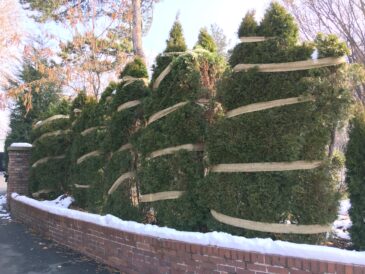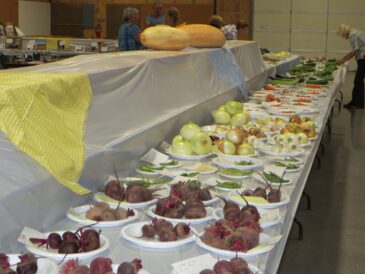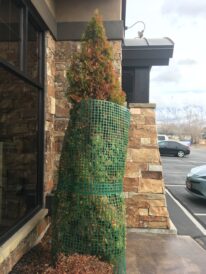Garden Help Desk: How to best protect arborvitae branches in winter

Courtesy Meredith Seaver
The loops of material you use for protecting your shrubs branches from the snow should be wrapped close enough together to prevent branches from poking free. Burlap strips like these are the most common snow-damage protection for shrubs, but any similar material could be used. Look for products that are breathable and sturdy enough to last throughout the winter.
My arborvitae had some bent branches after the last couple of snowstorms. I brushed off most of the snow and the branches straightened out, but what can I do to stop this without damaging the branches?
Some of my foundation plantings have boxwoods and a few of the branches got broken by snow and ice. How can I protect them this winter?
Any evergreen with long or soft branches — arborvitae, boxwood, laurel or juniper, for example — can be damaged when snow or ice accumulates on the branches, but there are a few things you can do to prevent this.
Wrapping the shrubs with long strips of burlap, tree wrap, or some other strong, soft product is a common way to prevent snow damage. Choose a material that will last through the winter. Start at the bottom of your shrubs and just wrap your way up to the top. Make the loops around the shrubs close enough and tight enough to keep the branches securely contained without breaking them.
Another method is to wrap the shrubs in plastic fencing material or breathable bags. Plastic fencing material is not as pliable as burlap, so you’ll need to fasten the edges to each other with zip ties, wire, twine or something similar to hold the wrapping together. Wrapping your shrubs like this may also discourage foraging deer. Hungry deer can find their way through almost anything but wrapping can slow them down.

Courtesy Meredith Seaver
Master Gardeners make new friends with common interests while volunteering to judge vegetable entries at the County Fair.
You can also just gently brush the snow off your shrubs after each snowstorm if you feel confident that you won’t forget to do it every time it snows.
Prevention is always the best option for both managing both snow and ice damage.
Wrapping is a good way to prevent snow damage, but even carefully wrapped shrubs can be damaged if you’re careless with your snow removal. If you have shrubs near a sidewalk or driveway, avoid throwing deep snow into those shrub beds when you clear the walks and drives. Not only will you reduce snow damage to your shrubs and small trees, you’ll also be reducing the amount of road salt and ice melt that gets into the soil.
Ice from melting snow on rooftops is a more difficult problem. The ice can become very heavy and break the branches on a shrub. The most effective solution is to install rain gutters and make sure they are clean and free-draining each fall.
If you’ll be planting new evergreen shrubs, avoid planting them in areas where ice and snow from your roof will collect. Also allow room in your shrub beds for shoveled snow storage without damaging your plants.

Courtesy Meredith Seaver
Flexible temporary fencing material is an unusual, and not particularly attractive, choice for snow protection. Any material that is flexible, breathable, winter-proof, and can keep the branches upright when it snows might do the job.
Can I prune my fruit trees and grapes now?
Hold off for a bit before doing your regular pruning. It’s best to avoid pruning during the weeks when temperatures fluctuate between cold and frigid temperatures. Not every part of Utah County will be past that point for a few more weeks.
Apples should be pruned in late winter — late January through February. Pears are next in line to be pruned. This is usually done by the end of February to reduce the risk of Fire blight infection.
Stone fruits like peaches, nectarines, apricots, cherries, and plums are best pruned in early spring, March through mid-April, depending on where you are and what the spring weather has been like. Plums and apricots don’t need as much pruning as peaches and nectarines, but it’s still a good idea to remove any dead, damaged, broken or rubbing branches every year. Suckers and water sprouts should also be removed.
Grapes tend to “weep” from their pruning cuts if they are pruned after they begin to break dormancy in the early spring. The weeping is harmless, but it bothers some gardeners to see it happening. You can avoid this by getting your grape pruning done in the late winter instead of waiting for spring.
Pruning is always easier when there isn’t any foliage on the branches, so keep an eye on the weather forecast and get that pruning done as soon as the weather cooperates to improve the yield and quality of your fruit this year.
Is there still time to register for the next Master Gardener course?
Yes, you still have time. Registration for the 2022 Master Gardener course closes on Jan. 20. Afternoon and evening classes will meet twice a week, Tuesday and Thursday, on Zoom beginning Jan. 25 and wrapping up the class sessions on March 17 — just in time for the beginning of spring gardening! All classes will be available virtually, with a few class sessions available both in person and on Zoom, along with one or two hands-on classes. Classes cover a wide range of topics, from basic plant science to fruit and vegetable production, soil science, and more. The same content will be covered in the afternoon and the evening classes on the same day.
Anyone is welcome to register and attend the classes. However, the goal of the Utah State University Extension Master Gardener program is to provide trained volunteers who can assist local USU Extension offices in bringing unbiased, research-based horticultural information and education to home gardeners, hobby orchardists, plant lovers, etc.
Class members who would like to become Certified Master Gardeners must also provide 40 hours or more of horticulture-related volunteer service. There are many options for completing volunteer service hours.
To find more information about class topics, registration costs and more, visit “USU Extension Master Gardener – Utah County” on Eventbrite.
Come learn and grow with us as you make new friends, learn lots of amazing things, gain new skills, and get involved in cool gardening projects in the area!
- The loops of material you use for protecting your shrubs branches from the snow should be wrapped close enough together to prevent branches from poking free. Burlap strips like these are the most common snow-damage protection for shrubs, but any similar material could be used. Look for products that are breathable and sturdy enough to last throughout the winter.
- Master Gardeners make new friends with common interests while volunteering to judge vegetable entries at the County Fair.
- Flexible temporary fencing material is an unusual, and not particularly attractive, choice for snow protection. Any material that is flexible, breathable, winter-proof, and can keep the branches upright when it snows might do the job.






